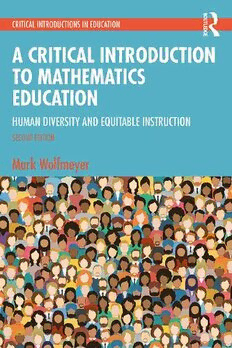
A Critical Introduction to Mathematics Education: Human Diversity and Equitable Instruction PDF
Preview A Critical Introduction to Mathematics Education: Human Diversity and Equitable Instruction
A CRITICAL INTRODUCTION TO MATHEMATICS EDUCATION The second edition of Mark Wolfmeyer’s award-winning primer offers future and current math teachers an introduction to the connections that exist between mathematics and a critical orientation to education, one that accounts for race, social class, gender, sexuality, language diversity, and ability. Expanded and updated from the first edition, this book demonstrates how elements of human diversity and intersectionality have real effects in the mathe- matics classroom, and prepares teachers with a more critical math education that increases accessibility and equity for all students. By refocusing math learning toward the goals of democracy and social and environmental crises, the book also introduces readers to broader contemporary school policy and reform debates and struggles, especially in light of Covid-19 and the ongoing struggle for racial equity. Featuring concrete strategies and examples in both formal and informal edu- cational settings, as well as discussion questions for teachers and students, text boxes with examples of critical education in practice, a glossary, and suggestions for further reading, Mark Wolfmeyer shows how critical mathematics education can be put into practice, relevant for undergraduate and graduate students in education, current teachers, and teacher educators. Mark Wolfmeyer is an associate professor in the College of Education at Kutztown University of Pennsylvania. Critical Introductions in Education Series Series Editor: Kenneth J. Saltman The Politics of Education: A Critical Introduction, 2e Kenneth J. Saltman Mathematics Education: A Critical Introduction Mark Wolfmeyer English Language Arts: A Critical Introduction Julie Gorlewski A Critical Introduction to Mathematics Education: Human Diversity and Equitable Instruction Mark Wolfmeyer For more information about this series, please visit: https://www.routledge.com/ Critical-Introductions-in-Education/book-series/CRITEDU A CRITICAL INTRODUCTION TO MATHEMATICS EDUCATION Human Diversity and Equitable Instruction Second Edition Mark Wolfmeyer Designed cover image: © GettyImages /PeterPencil Second edition published 2023 by Routledge 605 Third Avenue, New York, NY 10158 and by Routledge 4 Park Square, Milton Park, Abingdon, Oxon, OX14 4RN Routledge is an imprint of the Taylor & Francis Group, an informa business © 2023 Mark Wolfmeyer The right of Mark Wolfmeyer to be identified as author of this work has been asserted in accordance with sections 77 and 78 of the Copyright, Designs and Patents Act 1988. All rights reserved. No part of this book may be reprinted or reproduced or utilised in any form or by any electronic, mechanical, or other means, now known or hereafter invented, including photocopying and recording, or in any information storage or retrieval system, without permission in writing from the publishers. Trademark notice: Product or corporate names may be trademarks or registered trademarks and are used only for identification and explanation without intent to infringe. First edition published by Routledge 2017 ISBN: 978-1-032-34518-5 (hbk) ISBN: 978-1-032-34507-9 (pbk) ISBN: 978-1-003-32256-6 (ebk) DOI: 10.4324/9781003322566 Typeset in Bembo by SPi Technologies India Pvt Ltd (Straive) For mathematics teachers everywhere CONTENTS Preface ix Acknowledgments xii 1 What is mathematics? Answers from mathematicians, historians, philosophers, and anthropologists 1 2 Reform mathematics teaching: The student-centered approach 19 3 Why identity, human diversity, and intersectional identities matter to mathematics education 30 4 A white institutional space: Race and mathematics education 44 5 Social class hierarchies and mathematics education: To reproduce or interrupt? 60 6 Gender trouble: Rationalism vs. masculinity in mathematics education 73 7 LGBTQ+ work: Outing mathematics for heteronormativity and homophobia 88 8 Dissolving ability binaries in mathematics education: From special education law to disability studies 101 viii Contents 9 Language diversity as an asset: Emergent bilinguals in the mathematics classroom 114 10 Putting it all together: Intersectionality revisited, current mathematics education policy, and further avenues for exploration 127 Index 139 PREFACE This book is for mathematics teachers who want to teach for all learners in their classrooms. Many typically think that mathematics is objective and so straight- forward that teaching it should be universal; what works for one will work for anyone. However, we have such stark differences in student performance in mathematics, and these patterns in the data fall along distinct lines among our various identities. For example, why does the data indicate that white students always outperform students of color in our classrooms? This simply cannot con- tinue. Together we will realize that our teaching approaches are in part to blame. We cannot continue to teach our students with a one-size-fits-all approach. To perform better in the classroom, we’ll need to understand more deeply about human diversity and how it relates to mathematics instruction. We start in Chapter 1 by unsettling the notion that mathematics is objec- tive and clearly defined. Philosophers, anthropologists, and historians all paint a messy picture of the mathematical world. It is far from simple and beautiful in its complexities and varieties. Mathematics has been developed by a broad range of people across human diversity and throughout history; mathematics comes in a variety of forms from mathematical practices embedded in cultural life to math- ematical modeling that can solve challenging real-world problems to the pure mathematical inquiries full of deduction and reasoning. Mathematics is varied and diverse and as its teachers we reflect this diversity by widening what we offer students; we also approach mathematics instruction uniquely for each student to reflect their multiple identities. In Chapters 2 and 3, we continue to frame a mathematics instruction across the facets of human diversity. First, we review the dominant perspective in math- ematics education research today, typically referred to as the reform approach. Prioritizing student-centered instruction that emphasizes the “thinking” and
